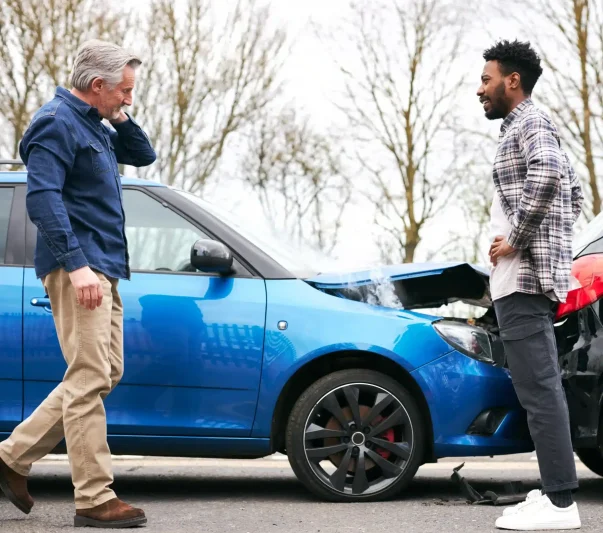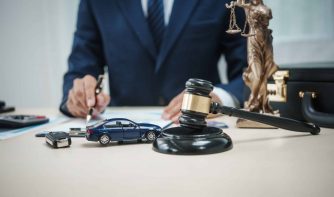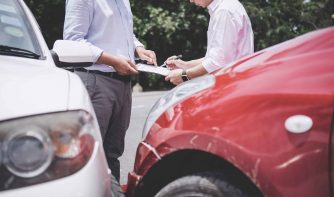Whether going to work or on vacation with our family, we drive almost every day. But in a world full of distractions, it takes one careless moment to cause a serious accident. In cases where it is determined that you were at fault, whether partly or entirely, Olson Personal Injury Lawyers is here to help you.
After an accident, it can be really confusing to determine who is at fault, even in an accident that is considered a fender bender. When multiple parties contribute to an accident, there is always the possibility that you may be deemed only partially at fault. Subsequently, drivers should never claim or assume liability in the event of an accident, even if there is pressure to do so. Always look to the assistance and experience of a proven Denver car accident attorney team.
You have legal rights even if the accident was determined to be partly your fault. At Olson Personal Injury Lawyers, our car accident lawyers have decades of combined experience fighting and finding justice to get you the compensation you deserve in Denver. Call us at (970) 633-3673 or contact us online today for a free, no-obligation consultation over the phone or in person at our local office.
How Olson Personal Injury Lawyers Can Help
Colorado became an at-fault state in 2003, which means that someone will be at fault in every incident. The at-fault party cannot seek liability insurance coverage for damages inflicted by their negligence. This is why it is crucial to call the police as soon as possible and document the incident. The police reports will provide a vital component in determining who is at fault in an accident.
When you reach out to a Denver car accident lawyer at the Olson Personal Injury Lawyers, we will review your case’s available details and relevant evidence during a free initial consultation. We will also consult with medical providers, law enforcement, and other experts to determine how much compensation you may be entitled to.
A car accident settlement in Denver may include economic and noneconomic damages, such as:
- Any incurred past and future medical bills
- Past and future rehabilitation costs
- Lost wages due to injury and time off work
- Property damage to your vehicle and other items
- Permanent disfigurement or disability that was caused by the accident
- Pain and suffering and mental anguish
Contributory Negligence Vs. Comparative Negligence
The state you live in determines how much compensation you will be eligible for.
Some states use a contributory negligence system, which completely bars any personal injury victim from seeking compensation when they have contributed in any way to the cause of their own accident.
States that use a comparative negligence system will still allow a victim to recover compensation for their injuries, albeit reduced by the proportion of fault they contributed. The plaintiff will be able to recover compensation depending on the degree of negligence of each party.
An example would be if a pedestrian walked into traffic while using their phone and was hit by a speeding driver. The jury may find that the fault was 50/50, and each party can only recover as much because of that. Additionally, this means both parties would also pay for the percentage of the damages caused to one another while still being able to recover damages for their own injuries.
Examples of Contributed Fault
Some examples of driving behaviors that can result in a finding of partial negligence include:
- Speeding past the posted speed limit
- Following the car in front of you too closely or tailing (rear-ending another car)
- Running a red light
- Failing to stop completely at a stop sign or “rolling” through a stop
- Failing to yield or merge safely into traffic when other traffic is coming from the opposite direction
- Changing lanes unsafely (not using blinkers or not looking before changing lanes).
- Allowing yourself to become distracted while driving in any way, including texting, scrolling through the phone, and having personal conversations
- Driving while under the influence of alcohol or drugs (D.U.I.)
- Driving on the wrong side of the road or pedestrian sidewalks
- Failure to maintain your vehicle properly (hydroplaning on a wet road with bald tires)
Any driver that finds themselves in an accident for any of the above is likely partly or fully to blame. When you are at fault, your liability insurance policy will cover the damages for the other party (decided by insurance and state rules). Additionally, you may see a hike in your insurance premiums because of the accident when you are at fault.
How Is Fault Determined?
Evidence is gathered at the accident scene and through any other available means to determine who is at fault for an accident. When the police officers arrive at the scene, they will analyze the situation and determine what happened. Parties involved are encouraged to take pictures of damage and injuries and record statements from anyone who may have witnessed the accident. Any additional photos might provide important information that can be used in court.
If you find a witness, make sure to take their name and contact information. The police officer may want to interview these witnesses to see if there are additional details they may have missed or should look at again.
Police investigators may take the time to forensically reconstruct an accident that resulted in major damages or a death. They will call in professional reconstruction experts, who use physical evidence left at the scene alongside their knowledge of physics and other disciplines to determine the accident’s cause. These investigations are especially useful in situations where someone involved in the accident made a false or inaccurate statement.
Fault can also be investigated independently through a Denver car accident lawyer team. The attorneys will consult with reconstruction experts and other professionals, gathering evidence that shows how and why the accident occurred.
Ultimately, though, fault is only legally concluded when a case advances to court and a jury finds fault to lie with one or more parties. In most cases, a car accident claim is settled out of court. However, the likely degree to which a driver is at fault will significantly influence an insurance company’s willingness to settle. Building a strong case helps at all phases of the car accident settlement process, regardless of whether or not a case goes to trial.
Car accidents can cause life-altering injuries and leave you with significant financial burdens. If you’ve been hurt due to someone else’s negligence, you may have the right to compensation. Our car accident lawyers are here to help you get justice.
Colorado is a Modified Comparative Negligence State
Under Colorado Law (C.R.S. § 13-21-111), the jury determines the at-fault party’s final determination of liability, the fault of the injured party, and the percentage of fault for both. Usually, in the police report, likely fault is documented with all of the relevant information tied to the accident.
All drivers are expected to act in a reasonably safe manner while driving. If the plaintiff and the defendant are both found to have disregarded their duty, the jury would decide each party’s negligence by a percentage depending on the accident.
If either party is found to exceed 50% fault, they will lose the right to receive compensation from the opposing party’s insurance.
Insurance Companies Conduct Their Own Investigations (So You Should, Too)
Colorado insurance companies play a large role in determining liability for car accidents. After an accident is claimed, the insurance company will send an experienced adjuster using factors like physical evidence and telemetric reconstruction to determine the party at fault and assess damages. The percentage of estimated fault documented by the representative determines how much the insurer will be willing to pay.
In addition, insurance adjusters may request the following information to help them make a conclusion about who’s at fault:
- Requesting a copy of the police report.
- Talking with witnesses who may have more details of the accident and what happened.
- Analyzing the time of day in correlation with traffic.
- Observing the weather conditions
- Inspecting the vehicle damage
- Collecting medical reports for any injuries sustained
Insurance company operatives have a strong incentive to reduce the financial liability of their policyholder. They may, therefore, attempt to prove comparative fault on the part of the claimant using the above forms of evidence. Injury victims should be cautious about speaking openly to a representative. Decline to make a recorded statement, and refer to the advice of an experienced car accident lawyer in Denver for help with negotiating your claim while protecting your own legal rights.
Questions About Our State Laws? Contact Olson Personal Injury Lawyers Today
If you were injured in a car crash where it is determined that you were entirely or partly at fault, it is in your interests to immediately consult with an experienced Denver car accident lawyer.
Working with insurance companies can be tricky and stressful while trying to heal emotionally and physically from a wreck. Your ability to receive fair compensation for your damages relies on compiling a strong case. It would be best if you did not have to pay for the negligent actions of another driver when you were not the only party who caused the accident.
When you work with the attorneys at Olson Personal Injury Lawyers, our skilled legal team is experts in handling complex car accident claims. We know how to investigate accidents, review evidence, and build strong legal cases. As a result, we have helped many injured victims get financial compensation for their losses.
Schedule a free, confidential, no-risk consultation with an experienced Denver attorney when you call (970) 633-3673 or contact us online. We can provide guidance, even if it was alleged that the collision may have been partly your fault. We would be happy to take some time to review your claim and explain your legal options to you at our local Denver office.







